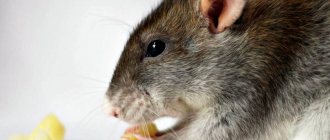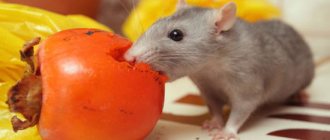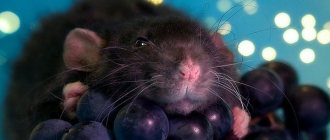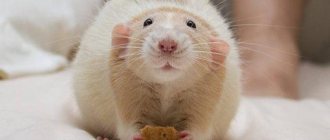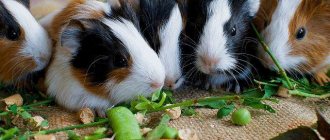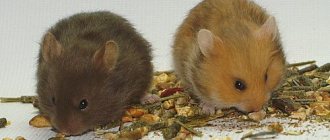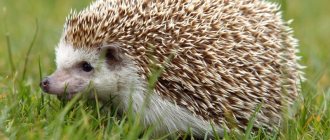Is it possible to feed domestic rats cheese, dairy and fermented milk products? Which foods will benefit your pets and which ones can be harmful to your health. What foods should be present in the diet. Feeding tips and advice.
We all know that rats are omnivorous animals and happily eat almost everything that their owner treats them to. But despite the fact that domestic rats are undemanding in choosing food, proper organization of the diet is very important.
There are products that will not bring any benefit to the animal and can even be harmful to health. Many people are interested in whether rats can eat cheese and dairy products. Then we will look at these issues in detail and learn about the benefits and harms.
Can I have milk?
Milk is very healthy; in addition to calcium, it contains vitamins A, D, E, and many microelements. But you should always remember that the human body is structured differently from that of animals.
A rat can have milk, but it should not be included in the daily menu. This product can cause digestive upset in rodents, so it can be given no more than 2-3 times a week and in small quantities.
In addition, remember that milk is a complete food and cannot be used as a drink; the rat must always have clean water, which changes regularly.
Should you give your pets kefir?
Kefir improves digestion and is easily absorbed by the body of rodents, therefore it is a useful product for tailed pets. But it must be remembered that animals should be fed only low-fat and non-sour kefir. Also, it is strictly forbidden to give animals stale or processed fermented milk products.
Which is strictly prohibited?
Above we got acquainted with milk, which is allowed to be included in the diet, and below are the types prohibited for consumption:
- Soy. Its use will lead to disorders, gas formation, and bloating.
- Coconut. It is an allergen and in most cases causes the development of severe allergies.
- Condensed. Rodents are prohibited from foods containing sugar; milk also contains a very high sugar content, which will certainly affect their well-being and health.
- Dry. Drinks made from such a product will not bring anything good, but they can cause harm.
Owners of decorative rats need to remember that despite the permits and prohibitions of a particular product, the animal may have allergic reactions to some food or other, and may also have lactose intolerance. New foods should be introduced as carefully as possible. Start with very small portions and be sure to monitor how you feel after that.
What mice eat at home and in nature
If you have decided to keep a rodent at home, then in addition to the integral details that ensure a comfortable life for your pet and care for it, it is important to know how to create an impeccable menu. Food should be tasty and include all the necessary vitamins
The easiest way, for example, is to use ready-made balanced industrial food specifically for mice. However, some are worried about quality and cook their own food. The nutritional composition is entirely determined by what small animals usually eat in natural conditions.
It can be:
- grains: barley, wheat, rye, oats;
- nuts and seeds: peanuts, hazelnuts, walnuts, sunflowers;
- fruits and vegetables: zucchini, carrots, pumpkin, cucumbers, bananas, apples;
- greens: dill, parsley, grain sprouts.
What do bats eat at home and who eats them in the wild?
Most people have no idea what to feed in the apartment; some even consider them vampires. In fact, there are several categories, each of which has its own feeding characteristics (insectivores, carnivores, sunbirds and others).
Those who keep an animal at home should find out what it was fed with in the wild. Based on this, select the necessary products.
Many bats prefer condensed milk diluted with water. Carnivores have an animal instinct; they love finely chopped meat, offal, and insects (worms, cockroaches). Other species require feeding with a variety of fruits, including bananas. They prefer milk and fresh water to drink.
In nature, bats have many dangerous enemies. Considering them as food, nocturnal birds of prey (kestrel, eagle owl), marten, ferret, ermine, weasel, and wild cats are able to hunt the animals. Sometimes even forest mice and rats do not allow them to live, making their way inside the shelter in winter, and do not disdain their relatives.
Do mice eat tomatoes?
Rodents hibernating inside a greenhouse pose a particular danger to those who breed tomato seedlings. In summer it’s hearty outside, but when it’s cold, you can taste young shoots of plants and ripening fruits. Pests feed only on cotyledons; if the remaining sprouts are sprinkled with ash, they will not be touched.
There are people who are not embarrassed by such a neighborhood. They specially plant seedlings with reserves for little gray animals. And holes and passages in the floor are regarded as good natural ventilation for their greenhouse.
What do field mice eat?
The vole can often be found in nature in meadows, forests, and steppes. Its nutrition, first of all, depends on its habitat.
It can be:
- herbs, their bulbs, plant roots;
- insects, larvae;
- seeds, cereals;
- tree bark, leaves, buds, cones;
- mushrooms, nuts, berries.
People have been debating whether mice eat cheese for a long time. A group of English scientists decided to verify this fact or refute it several years ago. You will learn about how the experiments ended and whether rodents really eat cheese in this article.
Cheese in a rat's diet
Many of us believe that cheese is one of the most favorite foods of rats, and they will never refuse such a treat. There really is some truth in this. They will never refuse aromatic and tasty cheese, but it should act as a delicacy, and not as an ordinary food in the daily diet.
The fact is that cheese is a very fatty product with a lot of salt and cannot be healthy in any way. In large quantities it will lead to obesity and other diseases. It can be given to the animal in very small quantities no more than once a week.
Owners should remember that not all types of cheese can be given to rats; some carry the risk of poisoning and allergic reactions.
The following varieties are prohibited:
- Brynza.
- Suluguni.
- Feta.
- Fused.
- Smoked.
- With mold.
- With increased % fat content.
In the event that an animal has liver disease, kidney disease, or gastrointestinal disorders, it is prohibited to give any types of cheese, as they will cause an aggravation and significantly complicate the situation.
Favorite characters
According to another version, perhaps this image was simply well played out by animators and caricaturists who were able to perpetuate this myth for many years. Today it is much easier to imagine and draw a mouse with a delicious slice of cheddar than with a crust of bread and a few grains of rice.
The creators of the popular animated series “Chip 'n' Dale Rescue Rangers” went even further. One of the rescuers is named Rocky, and his full name is Roquefort - in honor of the famous cheese. His father is Charlie Cheder and his mother is Katie Camembert. The main weakness of this daredevil is his incredible love for cheese; from the mere smell he falls into a trance and tries with all his might to get to the coveted piece. But the author’s idea hardly has any connection with reality. Rather, it is a fiction, nothing more.
Cottage cheese in the diet
Cottage cheese is quite healthy, which can be included in the diet, but in reasonable quantities. It is given in small quantities no more than once every 2 weeks. It should be given in its pure form without any additives; salt and sugar should not be given. When treating an animal for the first time, be sure to monitor the body’s reaction to the new product.
It is very useful during pregnancy and for females who feed their cubs. It is rich in vitamins and microelements and also improves lactation.
Conclusion
Mice are vegetarians. They will eat seeds, vegetables and fruits faster than cheese. But this does not mean that mice will ignore the product in question. If there is nothing suitable, these rodents will eat anything, including cheese.
Sources
- https://FB.ru/post/nature/2018/6/19/27023
- https://zen.yandex.com/media/factusios/myshi-i-syr-pravda-li-chto-pervye-tak-liubiat-vtoroe-ili-eto-vrane-5e24a5eb32335400ac8d97ac
- https://apest.ru/myshi/vse-o-myshah/edyat-li-myshi-syr/
- https://klause.ru/gryzuny/lyubyat-li-myshi-syr.html
- https://KOTiKo.ru/krysy/pitanie-krys/mozhno-li-krysam-syr-moloko-tvorog-i-drugie-molochnye-produkty.html
- https://likehamster.ru/domashnie-krysy/pitanie-krys/molochnye-produkty-krysam/
- https://zen.yandex.ru/media/id/5ca4d38ad92e0900b447a942/chem-mojno-kormit-krysu-a-ot-chego-luchshe-otkazatsia-5ce80e1fb2297700b54b7f45
- https://homkin.ru/krysy/pitanie-krys/mozhno-li-krysam-syr-i-moloko.html
[collapse]
Yogurt on the menu
So, first of all, let’s figure out whether a product such as yogurt can be introduced into the diet of your favorite animal. In fact, it is very useful, it contains vitamins, minerals and bifidobacteria necessary for proper digestion, but there is an important “but”.
Only natural yogurt is healthy, it does not contain sugar, dyes, flavors and various additives, they only harm your health. You should also not give store-bought yoghurts that contain pieces of fruit and berries.
A little history
Who knows where this myth came from.
Most likely, the traces lead to the Middle Ages. Before the invention of the refrigerator, storing food was much more difficult, so everyone got out of the situation as best they could: meat was attached to a hook under the ceiling, grain was kept in bags or barrels, and large circles of cheese were covered with wax or wrapped in linen. In those days, a hungry mouse agreed to eat anything. Meat hanging from the ceiling was harder to get, wheat or cheese was much easier to access. But the loss of several grains from the bag is not so noticeable, and teeth marks are treacherously visible on a piece of cheese. This may have led many to believe that mice love cheese. Even if in fact they only eat it because it turned out to be their only prey.
Main rules of feeding
Unlike their wild relatives, pets are very sensitive to food; diet is an important component of the health and life of the animal. They need to be fed in the morning and in the evening, due to the fact that animals are quite active at night, the main meal can be organized in the evening, for example, from 8 to 10 o’clock.
But many owners move the main meal to the morning, so the animals are active during the daytime, and at night they rest. Pregnant females are fed 4 times a day.
You need to be very careful when introducing new foods into your diet. The animal may have allergic reactions, so the portion should be very small the first time, be sure to monitor the reaction.
Animals need a variety of foods rich in vitamins and minerals, but the diet should include only healthy foods that are not harmful to health, these include:
- Cereals. They are rich in vitamin E, you can give corn, wheat, oats, millet, barley, seeds, oatmeal.
- Greenery. Dill, parsley, dandelion, plantain, cilantro, clover, radish.
- Vegetables. It should be given boiled without adding any spices.
- Meat. Only boiled and only lean, for example, chicken, turkey, beef. It is allowed to give meat puree, which is produced for kittens.
- Fish. Allowed in small quantities, only boiled, low-fat.
- Eggs. It is better to give hard-boiled quail. Should be on the menu no more than once a week.
- Nuts. Nuts are healthy, but only in small quantities. Almonds are prohibited.
- Dry food. You can buy food with a variety of additives at pet stores; they contain a large amount of vitamins and minerals.
- Fruits. These treats should only serve as treats and should be given rarely and in small quantities. It is forbidden to give peach and apricot pits; they contain hydrocyanic acid, which is a dangerous substance for rodents.
- Berries. They are very fond of raspberries, currants, blueberries, strawberries, but also, as in the case of fruits, rarely and in small quantities.
- Mineral supplements. Special mineral stones and chalk are also sold.
- Vitamin pills. You can buy special vitamins for the animal; a little fish oil is recommended.
The basis of the diet is cereals, herbs, vegetables, dairy products and cheese; they can only be an additive to the main diet. We must not forget that such supplements will only be beneficial in small quantities; if you do not adhere to this rule, you can harm your pet.
What to feed a little rat
A mother rat feeds her offspring with milk. However, there are times when she does not want to do this. In this case, responsibility for the life of the offspring will fall on the shoulders of the animal owner. To feed baby rats, you can purchase a lactating female at a pet store or feed the babies yourself.
To feed babies, you can use a pet milk replacer. Dry soy baby formula diluted with a small amount of goat's milk or condensed milk is also perfect.
Important! Liquid formula can be stored in the refrigerator for no longer than 12 hours.
The milk mixture will need to be warmed up a little. To feed your offspring, it is better to use an insulin syringe with an internal catheter at the tip. You can also take a pacifier made from pieces of cotton fabric.
After each meal, you should pour boiling water over the items. To avoid the development of enteritis in young animals, it is worth giving small rats a course of Biovestin.
Below you can find detailed information regarding the principle of feeding animals by week:
- In the first 7 days of a rodent's life, it is worth feeding them every 120 minutes. liquid diluted milk formula. Closer to the 7th day of life, it is worth diversifying the menu with milk formula, to which a small amount of dry ground grain feed has been added;
- in the second week, the mixture for rodents can be diluted to a consistency that will resemble liquid sour cream. You will need to drink the mixture every 3-4 hours;
- in the third week of life, you can pour the food mixed with the mixture into a bowl. From 23.00 to 6.00 you can not feed the offspring;
- At 4 weeks, animals can be switched to dry food. From the 30th day of life, rodents should be given food that is familiar to adults. If desired, rat pups can be fed milk until the end of the second month of life.
Babies will need to be given formula every 2 hours.
What menu should babies have? When choosing a diet for little rats over 4 weeks old, you should give preference to:
- dry grain;
- boiled chicken, turkey and fish fillets;
- cottage cheese;
- dill and cilantro;
- bananas;
- apples;
- wheat sprouts;
- oats;
- chicken egg yolks;
- boiled chicken and turkey liver.
Under no circumstances should children be allowed to indulge in:
- cucumbers;
- champignons;
- garlic and onions;
- tomatoes.
Note! When rat pups are fed milk by their mother, they can only be fed by the 21st day of life. It is best not to wean babies early from breastfeeding, which has a positive effect on strengthening the animal’s immunity.
Organizing the right diet for your beloved rodent is important; this will allow you to raise the animal healthy. It is important to give up the desire to pamper your four-legged friend with table scraps such as sweets and sausage, as this can provoke the development of various pathologies of internal organs.
Vitamin complex
For normal functioning of the body, rats need vitamins:
- To replenish vitamin A, rats eat milk, fishmeal and egg yolk. It affects reproduction and growth.
- Thiamine, or vitamin B1, is found in baker's yeast, dairy products and grass flour. It affects the functioning of the nervous system and the metabolism of carbohydrates in the animal’s body.
- Riboflavin, or vitamin B2, is found in grains and sprouts. He is responsible for the reproductive system.
- Pyridoxine, or vitamin B6, is found in grass flour, yeast and bran. Thanks to it, the risk of conjunctivitis and various skin diseases is reduced.
- Cobalamin, or vitamin B12, is found in fishmeal. Its source is also shellfish. Replenishes the lack of aminocarboxylic acids. Add to the diet in small quantities.
- Sources of ascorbic acid (vitamin C) include root vegetables, greens and fresh vegetables. It is given as a measure to prevent colds.
- Vitamin D is found in fish oil. It regulates the exchange of phosphorus and calcium in the body.
- Tocopherol, or vitamin E, is found in green food and sprouted grains. It is responsible for the functions of the reproductive system.
- The main sources of vitamin K are vegetable oil, green leafy vegetables, as well as liver and dairy products. Blood clotting depends on it.
If there is a lack of vitamins in your pet’s menu, you should buy a special vitamin complex in a pet store. To select vitamins for your animal, you need to contact a veterinarian. The selection depends on the individual characteristics of the domestic rat.
A properly designed nutrition menu will help kitty rats stay healthy for many years.
To choose food for a pet, the owner must pay attention to its characteristics. Rodents eat everything they are given, however, not all food is good for the animal.
Vegetables
Certain types of vegetables should not be included in your pet rat's diet:
- Vegetables from the Brassica family: turnips, radishes and radishes. They lead to increased gas formation in the intestines;
- any type of cabbage causes bloating in a rat;
- Potatoes contain a huge amount of starch, which is harmful to the rodent’s stomach due to difficulty in digestion. Tops and sprouts are harmful due to solanine;
- legumes (peas, beans, lentils and others) disrupt the functioning of the gastrointestinal tract. If the animal does not have digestive problems, it is allowed to give dried mung beans, chickpeas or peas.
- You should not feed your pet raw artichoke. Reduces pressure due to increased alkali levels;
- beets are allowed to be given only in small quantities. It has a laxative effect;
- Raw eggplants contain the toxic organic compound solanine. You can give the vegetable, previously peeled and boiled;
- It is undesirable to eat cucumbers. They cause stomach upset and diarrhea;
- animals should not eat tomatoes due to the oxalic acid content;
- garlic and onions irritate the gastric mucosa, because... contain biologically active substances phytoncides.





